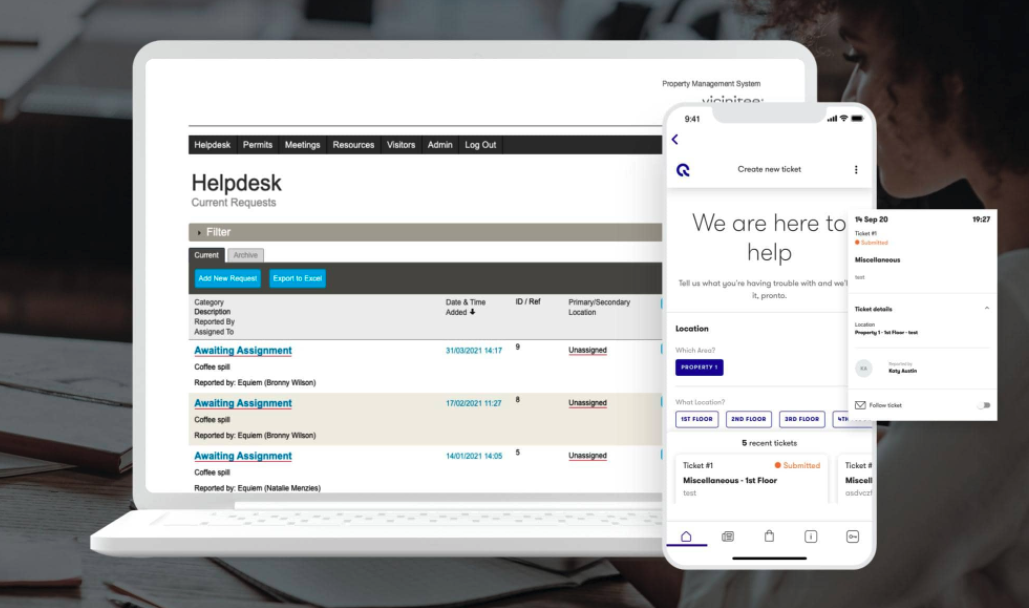Did you know that digital permit management software is the most "in demand" tech service for building contractors in the UK?
That's according to a recent survey of the many facilities managers that use Vicinitee, our very own property management software suite. To date, 11,000 contractors have used Vicinitee to raise permits, across 150 buildings. That makes it one of the fast-growing tech solutions in the market.
The World of Property Management Software Integrations
The property management software space is broad, with verticals covering everything from leasing activities to maintenance requests. As a result, unbundling is the normal method of adoption. Facilities managers select and pay only for the solutions they need, instead of purchasing an entire suite for a premium.
There's a challenge to going modular, however: Integrating disparate systems. If you choose one provider for your tenant app, another for your maintenance request system, and another still for your digital permits manager, it is unlikely that the back-end technologies will dovetail neatly together. Few platforms are agnostic. What happens, then, when a system you have used for years doesn't play nicely with a brand new one?
We see commercial landlords encounter this issue all the time. In our opinion, an ounce of prevention is worth a pound of cure. That is why we have designed our technology suite to be able to talk openly with other platforms. So, even if you come to us with an existing solution — say, a flexible space booking platform — you need not worry about how it will fit into the Equiem suite. Our Product team will get them working together on good terms.
The commercial real estate market is learning the power of tech agnosticism, of a single tenant app suite kitted out with bespoke integrations. In our experience, here are the three most common integrations landlords are looking at in 2021 and beyond.
Smart Building Solutions and IAQ Monitoring Systems
Smart buildings will become the hybrid-working hubs of the future. Indoor Air Quality (IAQ) tracking and monitoring systems are fast becoming an essential utility in the post-COVID office building, not least due to the proven benefits to employee productivity. If you can't prove that your office building is safe, clean, and more productive than the home office, you risk seriously dulling your value proposition.
Adopting an IAQ monitoring system, in most cases, takes a three-pronged approach:
- Software, to compute and display data to Facilities Managers and tenants
- Middleware, to help your endpoint software communicate with the hardware across your building
- Hardware, to actually measure the air quality
But it can get a whole lot more complicated. Let's say you want your IAQ system to feed its data through to your Salesforce account, or you want to use your tenant app to display data directly to platform users in real-time. That's when you need custom development work. With the right provider, and some time, you can do these very things. As time goes on, we will see smart building data flow into more and more of the leading property management systems.
Touchless Building and Tenancy Access Control
Even before COVID-19 hit, touchless access control was high on the integration wish-lists of many landlords. It's easy to see why: Managing access via traditional means is a cumbersome task. When tenant apps came along and said "we can make seamless, breezy building access a part of your community value proposition", many landlords leapt at the chance to be first adopters.
Touchless access has not yet hit critical mass in office buildings. But that doesn't matter, because this particular integration is one of the more "off-the-shelf-ready" solutions out there (to use the term very loosely). When you're ready to ditch the plastic access cards, we can work with your site system integrator and chosen access control provider (e.g. HID, Doordeck, and so on) to deploy a solution in matter of weeks.

Tenant Work Requests Systems with Vicinitee by Equiem
Vicinitee by Equiem includes a work requests manager. But many commercial landlords already have a provider of tenant work requests. What they need is way to surface these sole providers within the tenant app they choose. Users, therefore, have the option to lodge a work request in their tenant app, rather than the front-end of the third-party application.
We recently completed an integration with Building Engines to achieve this very purpose. By surfacing the Building Engines interface within our tenant app, we can now allow users of a particular building to lodge and track work requests in real time. The data is stored and tracked in the Building Engines interface, meaning no disruption to facilities management. It's a win for all concerned.



